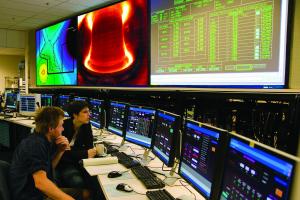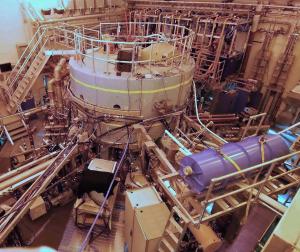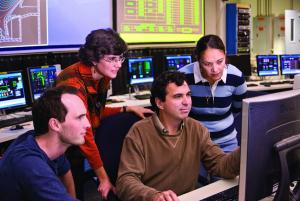Alcator C-Mod, a unique test-platform for ITER
In the northwest corner of MIT, away from the hustle of the campus center, a team of scientists, engineers, technicians, graduate and undergraduate students are investigating fusion, the energy of the sun and stars. The Nabisco Laboratory at the Plasma Science and Fusion Center (PSFC) is home to the Alcator C-Mod tokamak, an experiment that seeks to understand how to create a virtually endless source of energy on Earth.
Although the fusion process occurs naturally in the sun and the stars, on earth it requires unique machines, special knowledge, collaboration and a great deal of patience. A star has such a large mass that its own gravity holds its plasma together, allowing fusion reactions to continue and energy to be produced. In laboratory devices, because plasma particles will follow magnetic fields, magnets are used to hold the plasma together and away from the walls of its container, to confine it long enough for fusion to occur.
C-Mod is the third in a series of Alcator tokamaks developed at MIT since the 1960s. Characterized by a donut-shaped vacuum chamber wrapped in high-field magnets, the Alcator approach makes it possible to produce very dense and well-confined plasmas in a relatively compact device. (The name
"Alcator" comes from alto campo torus: high field torus.) This approach allowed an earlier experiment, Alcator C, to produce the first magnetically confined plasma with sufficient density and confinement to eventually achieve "breakeven." To actually realize breakeven would require higher temperatures than those reached in Alcator C.
Divertor Physics: Alcator C-Mod has a unique divertor system that uses specially shaped magnetic fields to "scrape'' away the cooler, outer edge of the plasma, draw it into an isolated channel on the bottom of the vacuum vessel, then pump it out of the machine. This is necessary because some ions escape from Alcator C-Mod's "magnetic bottle," and collide with the wall of the vacuum vessel, where they deposit their energy and become neutralized. Efficient divertor systems will be key elements in future fusion plants.
Plasma Control: The shape and position of the plasma is important. The edges of the plasma should be held away from the wall. Touching the wall cools the tenuous plasma and impairs the cleaning action of the divertor system. An elongated plasma shape, taller than it is wide, produces superior heating and confinement. The "Physics Operator" uses graphical computer tools to program the plasma's shape (and other parameters) before each shot. Fast feedback systems control magnet currents, gas valves, and other equipment during the shot to produce the desired results.
Radio Frequency Heating: Ions in the center of the plasma circulate around the magnetic field lines 80,000,000 times each second. When radio waves at 80 MHz, the ''ion cyclotron'' frequency, are injected into the plasma, the central ions absorb the wave energy, heating the plasma. Alcator C-Mod employs three antennae, and to date a total of five million watts of net power has been injected to heat the plasma to 80 million degrees Celsius at densities expected in ITER. The experiment seeks to discover how to optimize radio frequency heating in compact, high-field tokamaks, and to use the flexibility of this technique to study confinement and control of the plasma.
These areas of research, and the diagnostics used to explore them, are typical subjects of doctoral dissertations. Alcator C-Mod is one of the premier experimental facilities for training the next generation of plasma scientists. Typically there are about 30 graduate students working on Alcator C-Mod. On any given day a student could be running the experiment, collecting data and gaining new insights into plasma behavior.
Research on Alcator C-Mod contributes to an international tokamak project, being built in France: ITER. Designed to study the science of "self-sustained" (burning) plasma, ITER will be the largest tokamak ever created.
Fusion energy research at the MIT Plasma Science and Fusion Center is supported by the Office of Fusion Energy Sciences, US Department of Energy.




